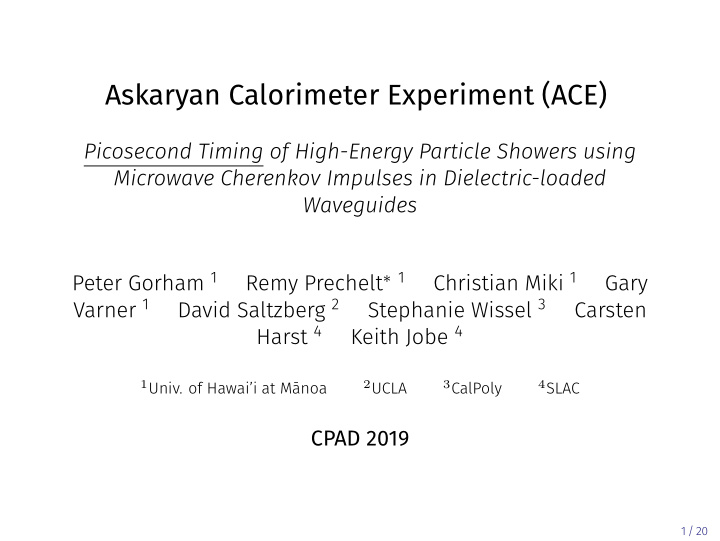



Askaryan Calorimeter Experiment (ACE) Gary CPAD 2019 Carsten 1 / 20 Waveguides Microwave Cherenkov Impulses in Dielectric-loaded Picosecond Timing of High-Energy Particle Showers using Remy Prechelt ∗ 1 Peter Gorham 1 Christian Miki 1 Varner 1 David Saltzberg 2 Stephanie Wissel 3 Harst 4 Keith Jobe 4 1 Univ. of Hawai’i at Mānoa 2 UCLA 3 CalPoly 4 SLAC
Instrumentation for New Physics of instrumentation requirements for a future 100 TeV-scale collider to potentially discover new physics: 1. 5 ps particle timing. Precise timing has been a recurrring theme. ACE has the potential to satisfy all of these requirements! 1 Hirschauer, Higgs as a tool for discovery (CPAD 2019) 2 / 20 Jim Hirschauer’s plenary 1 this morning laid out a very clear set 2. 10 mrad ( 4 ’) angular resolution. 3. Psuedorapidity coverage of | η < 6 | . 4. High radiation tolerance ( ≥ 10 18 neutrons/cm 2 ).
Askaryan Radiation alumina. orders of magnitude! shower energy across many Field strength is linear in (ANITA, ARA, ARIANNA). UHE neutrino experiments 3. The basis for a number of sand, salt, ice, and now 1. High-energy particle showers 2. Experimentally measured in bandwidth. shower) with many-GHz of the charge excess in the microwave Cherenkov from in dielectrics emit broadband 3 / 20 Askaryan radiation (coherent
The ACE Concept 1. We use standard WR51 copper waveguides loaded with alumina 2. The Askaryan radiation emitted in the (5-8 GHz). 3. We amplify and readout the nanosecond-scale pulse at each end with COTS amplifiers and oscilloscopes. 4. Alumina is a fantastic low-loss dielectric and one of the most radiation hard materials known. 4 / 20 (Al 2 O 3 ). alumina is coupled into the TE 10 mode
5 / 20
Experimental Validation (SLAC T530) Two experiments at SLAC (ESTB A) to explore the ACE concept: 1. ACEv1 (2015) 2 First generation waveguide design 2. ACEv3 (2018) Third-generation waveguide design. Performed in LHe. New 2K NF cryo-LNAs. Improved lower-threshold trigger system. ACEv4 already in development and is the best ACE yet! 3 ArXiV:1708.01798 6 / 20 Performed in LN 2 . ∼ 20K NF cryo-LNAs.
7 / 20
Waveforms 1. For both SLAC tests, one end of the waveguide was shorted so we see both the direct and reflected Askaryan pulse. 8 / 20
Timing Resolution 1. Signals measured by successive waveguides can be used to measure time-of-flight to picosecond precision. 2. The relative phase of the waveforms at each end of a waveguide can also give great spatial resolution along the long axis of the waveguide. 3. Measured time resolution for a single ACEv3 element was 9 / 20 ∼ 2 − 3 ps depending on SNR. 4. Time-of-flight resolution scales with ( √ N det ) − 1 so a four-element ACE layer approaches 1 ps resolution.
Dynamic Range 1. Askaryan emission is linear across many orders of magnitude! 2. Practical dynamic range is limited by the dynamic range of the chosen microwave LNAs. energy of 100 GeV). 4. Multiple (different) gain stages can be used to further increase dynamic range. 10 / 20 3. For an ACEv3-like system, with ∼ 30-40dB of gain on a thermal background of ≈ -96dBm, the dynamic range would be ≥ 1000 in shower energy. (100 TeV for a turn-on
Turn-on Shower Energy 1. The minimum detectable shower energy is primarily determined by the system temperature, T sys 2. For the three-element ACEv3 with 2K cryo-LNAs, the 3. The minimum shower energy scales with systems with more elements, better LNAs, and different waveguide designs, could lead to turn-on energies 11 / 20 minimum shower energy ∼ 200 GeV. √ T sys / N det so ≤ 100 GeV.
12 / 20
What might this look like for the FCC-hh? 2 When in doubt, Monte Carlo! 13 / 20
14 / 20 Barrel Detector y 1 mm Cu x 13 mm ~ 30 mm 6.5 mm Waveguide Length: ~ 1 m
15 / 20
16 / 20
Angular Resolution waveguide. 2. In the perpendicular direction, our spatial resolution is point, this corresponds to an angular resolution of 10 This easily exceeds the 34 arcminute requirement set by Jim this morning! 17 / 20 1. A resolution of ∼ 1 ps in alumina corresponds to a spatial resolution of ∼ 100 µ m along the long-axis of the limited by the 6 mm width of the waveguide. 3. Assuming an ACE layer at 2 m radius from the interaction arcseconds in θ and 6 arcminutes in φ in the barrel. 4. This is improved in the forward region where d θ ≈ 100 arcseconds and d φ ≈ 10 arcseconds at η = 3 .
Calorimetry 18 / 20 =0 =1 =2 0.05 0.05 0.05 0.04 0.04 0.04 0.03 0.03 0.03 E E 0.02 0.02 0.02 0.01 0.01 0.01 10 100 1000 10000 10 100 1000 10000 10 100 1000 10000 =3 =4 =5 0.05 0.05 0.05 0.04 0.04 0.04 0.03 0.03 0.03 E E 0.02 0.02 0.02 0.01 0.01 0.01 10 100 1000 10000 10 100 1000 10000 10 100 1000 10000 Shower pT [GeV] Shower pT [GeV] Shower pT [GeV]
Summary 1. ACE elements are extremely simple in design, low-cost, orders of magnitude). 3. Timing resolution is at most a few picoseconds for almost all events, pushing down to sub-picosecond in the forward region and for several-TeV events in the barrel. 5. Can also provide decent calorimetry for high-energy or 19 / 20 extremely rad-hard, with extreme dynamic range ( ≥ three 2. Realistic turn-on energy of ∼ (100 − 200) GeV for 4 elements (or a pT of ∼ (3 − 8) GeV/c at η = 4 ). 4. Angular resolution for typical collider geometries is O (10) ( O (100) ) arcseconds in θ and O (60) ( O (10) ) arcseconds in φ in the barrel (forward) region. high- η events. 6. Potentially a transformative ∼ 5D vertexing technology?
Questions? 20 / 20
Recommend
More recommend